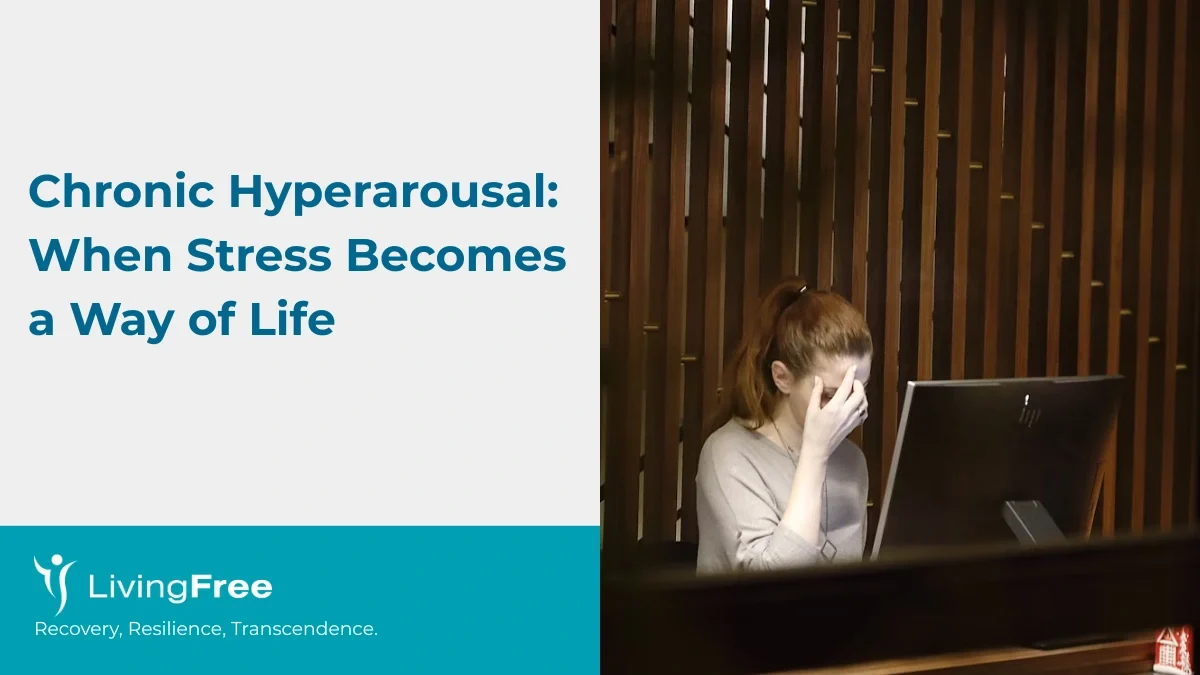Chronic hyperarousal happens when the body’s stress response never turns off. The heart stays fast, muscles remain tense, and the mind feels alert even during rest.
Over time, this state becomes the new normal. The nervous system forgets how to relax, and constant vigilance becomes a way of living.
Understanding Chronic Hyperarousal
Hyperarousal is part of the body’s natural survival system. It activates the sympathetic nervous system, preparing you to react quickly to danger.
In a balanced system, the parasympathetic nervous system brings calm once the threat passes. When stress or trauma is ongoing, this recovery process breaks down, leaving the body stuck in a state of readiness.
This prolonged activation keeps energy high but drains emotional and physical reserves over time.
How Chronic Hyperarousal Develops
Unresolved Trauma
After trauma, the body can stay “on guard” even when danger is gone. The brain associates safety with vigilance, and the nervous system keeps releasing stress hormones.
Without support, this pattern becomes chronic, leaving the person unable to return to baseline calm.
Ongoing Stress
Long periods of work pressure, family strain, or emotional distress can push the body into constant activation.
Each day of worry adds another layer of tension until hyperarousal feels automatic.
Poor Sleep and Exhaustion
Insufficient rest prevents the nervous system from resetting. Elevated cortisol remains in the bloodstream, keeping the body alert through the night and tired by day.
This cycle repeats, making deep rest feel unreachable.
Stimulant Dependence
Caffeine, nicotine, and energy drinks can worsen alertness and anxiety. In a hyperaroused body, even small amounts can increase heart rate, tremors, and restlessness.
Suppressed Emotions
When fear, anger, or grief are never expressed, the energy stays in the body. The result is tight muscles, irritability, and moments of emotional outburst.
The nervous system remains charged because it never completed its stress response.
Signs You May Be Living in Chronic Hyperarousal
- Constant irritability or sudden anger
- Difficulty relaxing even in safe places
- Tension headaches or chronic pain
- Feeling tired but unable to sleep
- Stomach or digestive problems
- Racing thoughts or intrusive memories
- Fast heartbeat, shaking, or dizziness
- Feeling detached or emotionally numb
These signs suggest that the nervous system has adapted to stress as its baseline state.
The Emotional and Physical Cost
Emotional Burnout
The constant readiness to react eventually leads to exhaustion. You may feel drained, hopeless, or emotionally flat.
To cope, some people withdraw or detach from their emotions entirely, which can resemble depression.
Relationship Strain
When the body is always on alert, even small conflicts can feel threatening. Partners or family members may misinterpret these reactions as anger or indifference.
Understanding hyperarousal as a physiological response helps reduce blame and opens space for empathy.
Health Impact
Chronic hyperarousal keeps the body flooded with stress hormones. Over time, this can cause high blood pressure, inflammation, and fatigue-related disorders.
The immune system weakens, digestion slows, and the risk of heart disease increases.
Cognitive Overload
The brain struggles to focus or remember details under constant stress.
Tasks that once felt easy become difficult, and decision-making feels overwhelming. This cognitive fatigue is a common sign that the brain is overworking to stay alert.
Breaking the Cycle of Chronic Hyperarousal
Regulation begins with awareness and small, consistent actions that signal safety to the body.
The goal is not to eliminate stress completely but to help the nervous system recover flexibility — the ability to move between alertness and rest.
Step 1: Recognize Early Signs
Pay attention to when your body feels tense or restless.
Notice what thoughts, environments, or situations increase your heart rate or trigger irritability. Awareness helps you catch activation before it escalates.
Step 2: Ground the Body
Use quick regulation techniques when you feel triggered.
Try slow breathing at five to six breaths per minute or do the 5-4-3-2-1 sensory exercise to anchor yourself in the present.
Repeating small grounding practices throughout the day helps the nervous system trust that it can return to safety.
Step 3: Prioritize Rest
Rest is essential for recovery. Create routines that signal to the body that it can slow down.
Dim lights in the evening, reduce screen time, and use gentle relaxation methods like stretching, reading, or warm baths before bed.
Step 4: Move Consistently
Gentle physical movement helps release stored tension.
Choose activities that combine breath and rhythm such as yoga, tai chi, swimming, or walking. Avoid extreme intensity that increases adrenaline.
Movement teaches the body that energy can be released safely instead of through stress reactions.
Step 5: Reconnect with Others
Safe, calm relationships help regulate the nervous system through co-regulation — the body’s ability to mirror another’s calm.
Spend time with supportive people, share how you feel, or simply sit quietly together. Connection reminds your system that safety exists beyond isolation.
Step 6: Seek Professional Guidance
If chronic hyperarousal continues, trauma-informed therapy can help retrain the nervous system.
Approaches like Somatic Experiencing, EMDR, or Polyvagal-informed therapy address both the body and mind.
A qualified therapist can guide you through triggers at a safe pace and teach practical regulation tools.
Restoring Life Beyond Survival Mode
Healing from chronic hyperarousal takes time. The nervous system does not change overnight, but it does respond to consistency and compassion.
Each moment of calm — a slower breath, a deeper sleep, a relaxed muscle — becomes a new lesson in safety.
With steady practice, the body begins to remember what peace feels like, and calm becomes not a goal, but a lived experience again.
Related Reading:
How to Calm a Hyperaroused Nervous System
Signs and Symptoms of Hyperarousal You Shouldn’t Ignore
What Causes Hyperarousal? Understanding the Body’s Alarm System


